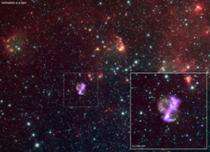Unusual shape of exploded star puzzles scientists

Penn State astronomers have used NASA's Chandra X-ray Observatory to produce a new image of a ghostly exploded star with an unusual shape in a galaxy near the Milky Way. Astronomers think the object may be the remains of a white-dwarf star that disintegrated in a thermonuclear explosion, known as a Type Ia supernova, but it does not look like other likely Type ia remnants found in our own Milky Way galaxy.
The research that led to the new image of this object was led by Penn State astronomers Sangwook Park and Jae-Joon Lee, and is being presented this week at the 214th meeting of the American Astronomical Society in Pasadena, California. The strange object, known as SNR 0104-72.3 (SNR 0104 for short), is in the Small Magellanic Cloud galaxy, which is a neighbor of our Milky Way galaxy.
This composite image of SNR 0104 is made of X-rays from Chandra, shown in purple, and infrared data from NASA's Spitzer Space Telescope, shown in green and red. Instead of having a circular shape, the object is dominated by two bright lobes of emission (on the upper right and lower left). The large amount of iron in these lobes indicates that SNR 0104 was likely formed by a Type Ia supernova.
According to Park and Lee, one possible explanation for this structure is that the explosion of the white dwarf itself was strongly asymmetrical and produced two jets of iron. Another possibility is that the complicated environment revealed in the image may have caused the unusual shape. The green shells on the left and right side of SNR 0104 correspond to surrounding material that has been swept up by the explosion. So, the unusual shape of the remnant might be caused by a lack of material to the north and south of the star, leaving a clear, outward path for the stellar debris. This explanation, however, is still in question, and scientists hope more data from Chandra and other telescopes will help to settle the debate.
The presence of a nearby massive star and the shells of gas and dust seen in the wide-field view from Spitzer shows that SNR 0104 might be located within a star-forming region. This possibility suggests that SNR 0104 may belong to a little-studied class of so-called "prompt" Type Ia supernovas, which are caused by the demise of younger, more massive stars than the average exploding white-dwarf star. More data will be needed to test this theory.
Source: Pennsylvania State University




















